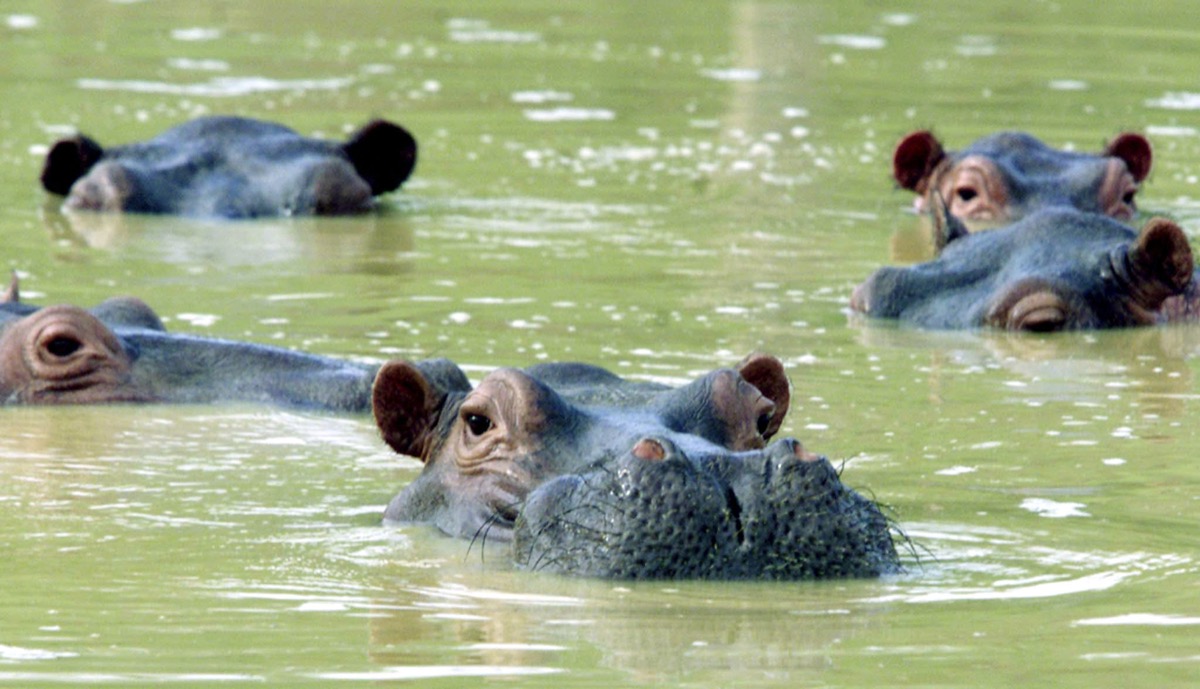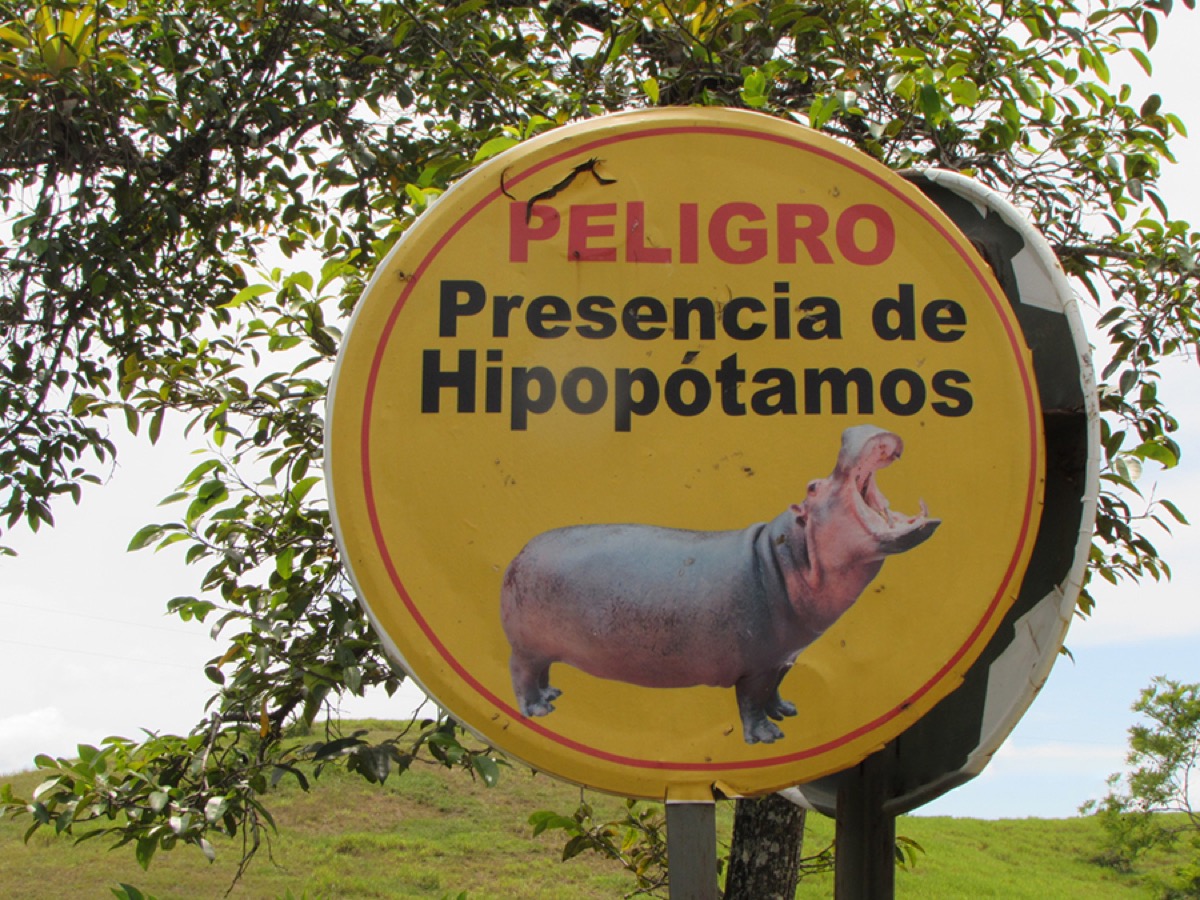Rethinking Invasive Species With Pablo Escobar’s Hippos
15:25 minutes

 Colombia is home to an estimated 80 to 100 hippos. The large mammals spend most of their time eating plants on land and staying cool in the water. In Colombia, they’re an invasive species—hippos are native to Africa. But notorious drug lord Pablo Escobar brought four to the country as part of his private zoo. After his death in 1993, the hippos escaped to the wild where they thrived.
Colombia is home to an estimated 80 to 100 hippos. The large mammals spend most of their time eating plants on land and staying cool in the water. In Colombia, they’re an invasive species—hippos are native to Africa. But notorious drug lord Pablo Escobar brought four to the country as part of his private zoo. After his death in 1993, the hippos escaped to the wild where they thrived.

Some locals consider them pests, the government has mulled over getting rid of them, and recent studies have shown that their large amounts of waste is changing the aquatic ecology of Colombia.
But new research has taken a different view, showing that even though hippos are invasive, they might be filling an ecological hole left by large herbivores killed off by humans thousands of years ago. Take, for instance, the closest native comparison—the Hemiauchenia paradoxa, a large, early llama. The mammal was likely hunted to extinction by early humans looking for food.
Erick Lundgren, the study’s lead author and a Ph.D. student at the University of Technology in Sydney, Australia, talks about why we should stop thinking of the phrase “invasive species” as inherently bad, and what may be in store for the future of these hippos.
Invest in quality science journalism by making a donation to Science Friday.
Erick Lundgren is a Ph.D. student in Ecosystem Processes at the UTS Centre for Compassionate Conservation in Sydney, Australia.
IRA FLATOW: This is Science Friday. I’m Ira Flatow. Columbia is home to somewhere between 80 and 100 hippos. These huge mammals spend most of their time eating plants on land and staying cool in the water. But they’re an invasive species native to Africa.
Some locals consider them pests, the government has mulled over getting rid of them, and recent studies have shown they’re having a negative impact on the Colombian environment. But now, new research has taken a different view, showing that, even though hippos are invasive, they might be filling an ecological hole left by herbivores killed off by humans thousands of years ago. Producer Kathleen Davis spoke with Erick Lundgren, the lead author on this new study. He’s a PhD student at the University of Technology in Sydney, Australia.
KATHLEEN DAVIS: So Erick, what does the study about invasive species have to do with Colombian drug lord Pablo Escobar?
ERICK LUNDGREN: Well, it’s a great question Pablo Escobar is an infamous character. He was a very successful drug lord in Colombia. And he loved animals.
He had his own private zoo in his stronghold fortress. And in that zoo were his favorites, which were hippos. And when Pablo Escobar was killed, those hippos were left to be. And they have bred, and they have left the zoo and are showing up as far as 200 miles away in the river system there. And they estimate that there’s now between 80 and 100 of these animals.
They are the largest introduced species to be flourishing in the world. Hippos are, of course, endangered in their native range. And it presents a really interesting ecological question in Colombia, where they’ve been introduced.
KATHLEEN DAVIS: So what kind of impact do these hippos have on the Colombian environment?
ERICK LUNDGREN: Well, that’s an open question. A paper was recently published that found that, much like in Africa, these hippos are feeding in the terrestrial environment. They’re leaving the water, they’re going upland, and they’re grazing. And then they come back to the water, and they defecate in the water.
And in Africa, that plays a really amazing keystone role in fertilizing water bodies and increasing productivity. In Africa, hippos are responsible for vastly boosting fish production, waterbirds, et cetera. We know that they’re moving nutrients in Colombia, but we don’t know what the downstream effect of this is going to be.
KATHLEEN DAVIS: So in this new study, you and the other researchers say hippos might actually act as a substitute for another large herbivore that was wiped out by people thousands of years ago. What did this animal look like, and how are hippos acting like them, in a way?
ERICK LUNDGREN: Well, it’s not one specific animal that they seem like in the past. But if you broaden our perspective of what nature is to begin not when Christopher Columbus discovered the New World, but towards the larger evolutionary context of Earth’s history, before humans arrived in South America, South America was full of giant, strange animals. And many of those are quite similar to hippos, although sometimes in different combinations of traits.
So hippos are strangely most similar, when you look at all their traits in total, to a giant llama, which is kind of a ludicrous comparison. But they’re also very similar to these rhino-like notoungulates, which were probably semi-aquatic. And so hippos are kind of like a Greek chimera of all these different extinct species. And there’s a real strong chance that what they’re doing in Colombia in these rivers resurrects certain processes that were once widespread on that continent for 30 to 40 million years.
KATHLEEN DAVIS: Do we know why these llama-type animals and the other big herbivores that were living in South America were killed by ancient people?
ERICK LUNDGREN: Well, I think people were hungry. And this is a topic of debate for decades now. But as humans left Africa, pretty much everywhere we went, the large animals disappeared shortly afterwards. In some places, it’s happened really recently, like 800 years ago in New Zealand. The giant flightless birds– the moa– disappeared when humans arrived.
In Australia, 80,000 years ago, a huge pantheon of bizarre animals– giant wombats and hoofed, horse-like kangaroos– all disappeared when humans first arrived. It’s similar in Europe. Africa is really the only place where the type of herbivory that is really characteristic of the Earth still survives today.
KATHLEEN DAVIS: What else do we know about these early humans?
ERICK LUNDGREN: Well, we know that they were sophisticated hunters. And those that came into North and South America came through Eurasia, where there was a culture of hunting mammoths. And there’s a lot of people that push back on the idea that humans could have caused these extinctions, although the evidence is increasingly clear that they were the driver.
I personally wonder if these people– and this is just a wondering– came in a state of some degree of chaos and persecution that would lead to perhaps over-using natural resources, as we have done often in the modern world. But it really remains unknown. I wish we could have a teleport into the cultures and minds of the people back then.
KATHLEEN DAVIS: That’s really interesting. I want to play a clip from a conversation I had with Jonathan Shurin, who wrote the study that you mentioned earlier about the ecological effects that hippos are making to the aquatic environment in Columbia. Jonathan is a professor at the University of California, San Diego.
JONATHAN SHURIN: In the actual case of the hippos, they’re most similar extinct species is not very similar. So I would say what that really says is that there wasn’t anything very similar to a hippo. So hippos are not sort of replacing anything that used to be there.
KATHLEEN DAVIS: Erick, can you respond to this point that Jonathan raises?
ERICK LUNDGREN: Of course. Hippos are a very unique species. They are quite unlike anything else.
But they are bulk grazers. They are able to eat tons of dry, fibrous grass matter. And so can other species, like these extinct llamas and many other grazers in South American Pleistocene.
Hippos’ uniqueness is also that they’re semi-aquatic and, to the best of our knowledge, notoungulates in South America. Some of them most likely were semi-aquatic. Now, we can’t, unfortunately, go back in a time machine. But many species that we don’t even consider to be semi-aquatic often used wetlands strongly. Near where I live, wild horses are constantly feeding and defecating in the Salt River of Arizona. So if you look at the sum total on these broad evolutionary timescales of herbivores affecting the environment, the effects of hippos do not seem so novel. They seem awfully novel when you compare their effects to native species in South America, which are all small-bodied and all the ones that have survived these dramatic extinctions.
KATHLEEN DAVIS: So we’re conditioned to think of the term “invasive species” as bad. It seems like, here, you’re trying to reframe how we think about that phrase.
ERICK LUNDGREN: Yes. The term “invasive species” carries a great deal of emotional connotation. It implies almost as if these organisms built ships and came over here with the intent to rape and pillage. And with that kind of branding from the beginning, it really constricts our ability to ask questions about what these animals are doing.
If these organisms are harmful by definition, then how would we ever ask questions that might find that they do other things, like facilitative things? And so across the field of ecology and conservation biology, the term “invasive” seems to be increasingly problematic when you look at the nuances of how organisms interact with each other. In fact, it’s been said by many that, if we came to this place in South America, and you tried to determine what species were native or invasive simply by how they were affecting each other, without any knowledge of the history of those species, you would have no clue. And so I think that broadening our perspective, especially in this time of mass extinctions and global change, is really necessary to make informed, effective, and ethical decisions when it concerns life on Earth.
KATHLEEN DAVIS: Is there still a lot that we don’t know about how human-introduced big herbivores play into their new environments?
ERICK LUNDGREN: Oh, there’s so much we don’t know. For the most part, these introduced species have been studied, as you’ve mentioned, with the assumption that they are, by definition, harmful. And if we ask different types of questions, we find out all sorts of different stories.
So for instance, wild boar– wild hogs– are maybe the most vilified of introduced species. And we read about them everyday and how they wreck and wreak havoc on native ecosystems. But if you study them with a different perspective, recognizing that what they do by rooting soils is something that many species have done for millions of years in both Australia and North and South America– in North America, there were giant peccaries– giant pig-like animals that, until the late Pleistocene, were rooting soils.
And that rooting behavior is actually really interesting. So in Tennessee, researchers found that tree growth rates are increased by rooting, because the pigs are turning leaf litter into the soil and increasing decomposition rates. They’re acting like giant fertilizers. In Australia, a study found that, while birds will avoid pigs at the moment that pigs are in a place, the birds will flock to those areas and feed on the excavated soils, because the pigs have made termites and fruits and seeds more available for consumption.
So if you study these animals only from this perspective of harm, you find one type of question and one type of answer. And it’s always proven right. If anything these animals do is harmful, then it’s just a matter of showing that they do anything. But, if you ask questions about these animals as megafauna, as herbivores, and in terms of the deep paleoecology of this planet, you find different types of questions and different types of answers.
KATHLEEN DAVIS: How common is this type of situation for big herbivores? So are these Colombian hippos one example of just a few times humans have moved around big plant-eaters, or is this something that’s happened many times before?
ERICK LUNDGREN: Well, that’s really the focus of the study, is that this is, in some ways, a counter-current force to the extinctions we have brought around the world. We have replaced almost 50% of this lost species richness in some continents with introduced species– 33 introduced herbivores, in total. And this effect appears to be counteracting the legacies of these prehistoric extinctions.
Australia is probably the most rich, in terms of these introduced herbivores. They have donkeys, and horses, and several species of deer and water buffalo, and the world’s only population of wild dromedary camel. And these animals are doing really fascinating things in the landscape, but are subject to the most brutal eradication campaigns you can imagine.
KATHLEEN DAVIS: What kind of eradication campaigns are we talking about here?
ERICK LUNDGREN: Well, there are a lot of aerial gunning of camels, for instance. They do something really tragic to wild donkeys called the “Judas technique–” some biblical undertones there– where they collar a female donkey with a radio collar, and then they release her. And then, donkeys are, of course, very social and intelligent animals. And that female will find a herd of friends. And then, two months later, a helicopter will come and shoot all of those other donkeys and let the female go find another herd. And then two months later, the helicopter will come back.
And eventually, this Judas donkey– this female with the collar– will give up, at which point she’ll be shot, and the collar will be put on another donkey. And using this technique, they’ve eradicated, I think, around a million donkeys in northwestern Australia. And this is in the pursuit of restoring nature to some semblance of how it was found by Europeans when they arrived. But that term, “nature,” is what needs to be interrogated.
KATHLEEN DAVIS: You’re listening to Science Friday from WNYC Studios. What do you think it’ll take for people to reframe this idea of invasive?
ERICK LUNDGREN: Well, I think it’ll take shows like this and conversations, many of which will be quite contentious– I’m expecting a pretty fierce reply to what we just published– and I think it’s part of culture. It’s everyday people thinking about these questions. What does the term “belonging” mean that we so often use and hear when we think about the natural world?
And what is change? When we see a wetland that’s crisscrossed with trails from an introduced herbivore, is that harm? Or is that maybe the restoration of how wetlands looked for 40 million years? And so I think a little bit of mindfulness and humility in how we think nature should be will go a long ways in changing this situation.
KATHLEEN DAVIS: To bring it back around to these Colombian hippos, some people consider them pests. And I know the government has considered killing them. What do you hope for the future of these hippos?
ERICK LUNDGREN: Well, I think it would be fascinating to study them without any notion of them being good or of them being bad, but to study them as megafauna. What is the effect of their grazing in the uplands, in the riparian meadows in Colombia, and then defecating in the rivers? Is it facilitating fish or not?
And Shurin, in that paper you mentioned, is a great first step. But there’s so much more to learn. And I think we learn it best when we drop the idea that these animals are either saviors of the environment or pests of the environment. And when we do science in a more objective way, free from these labels, I think we’ll find more interesting stories, not only to fill us with wonder and curiosity, but also to help us go forward and make decisions that may be difficult to make.
KATHLEEN DAVIS: Erick, thank you for joining me.
ERICK LUNDGREN: Thank you so much, Kathleen.
IRA FLATOW: Science Friday Producer Kathleen Davis speaking with PhD student Erick Lundgren from the University of Technology in Sydney, Australia.
Copyright © 2020 Science Friday Initiative. All rights reserved. Science Friday transcripts are produced on a tight deadline by 3Play Media. Fidelity to the original aired/published audio or video file might vary, and text might be updated or amended in the future. For the authoritative record of Science Friday’s programming, please visit the original aired/published recording. For terms of use and more information, visit our policies pages at http://www.sciencefriday.com/about/policies/
Kathleen Davis is a producer and fill-in host at Science Friday, which means she spends her weeks researching, writing, editing, and sometimes talking into a microphone. She’s always eager to talk about freshwater lakes and Coney Island diners.
Ira Flatow is the founder and host of Science Friday. His green thumb has revived many an office plant at death’s door.